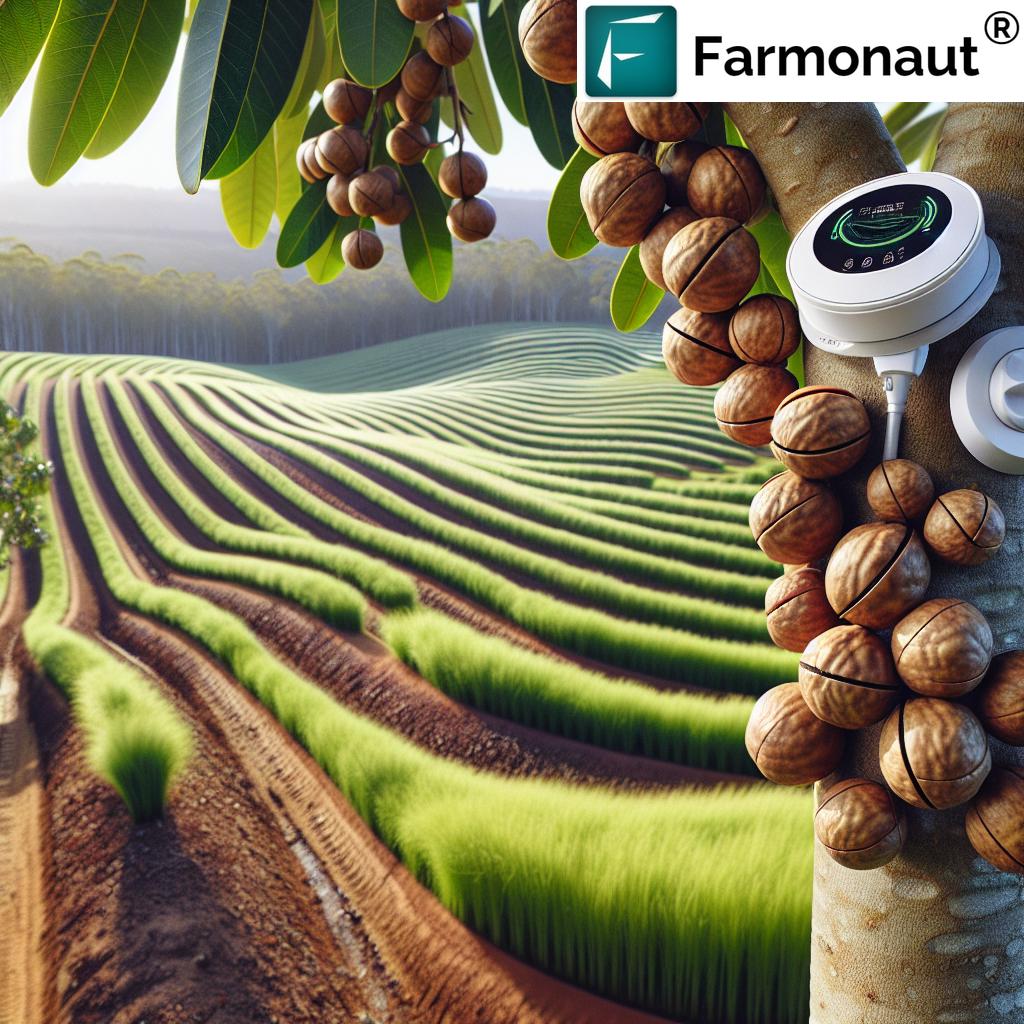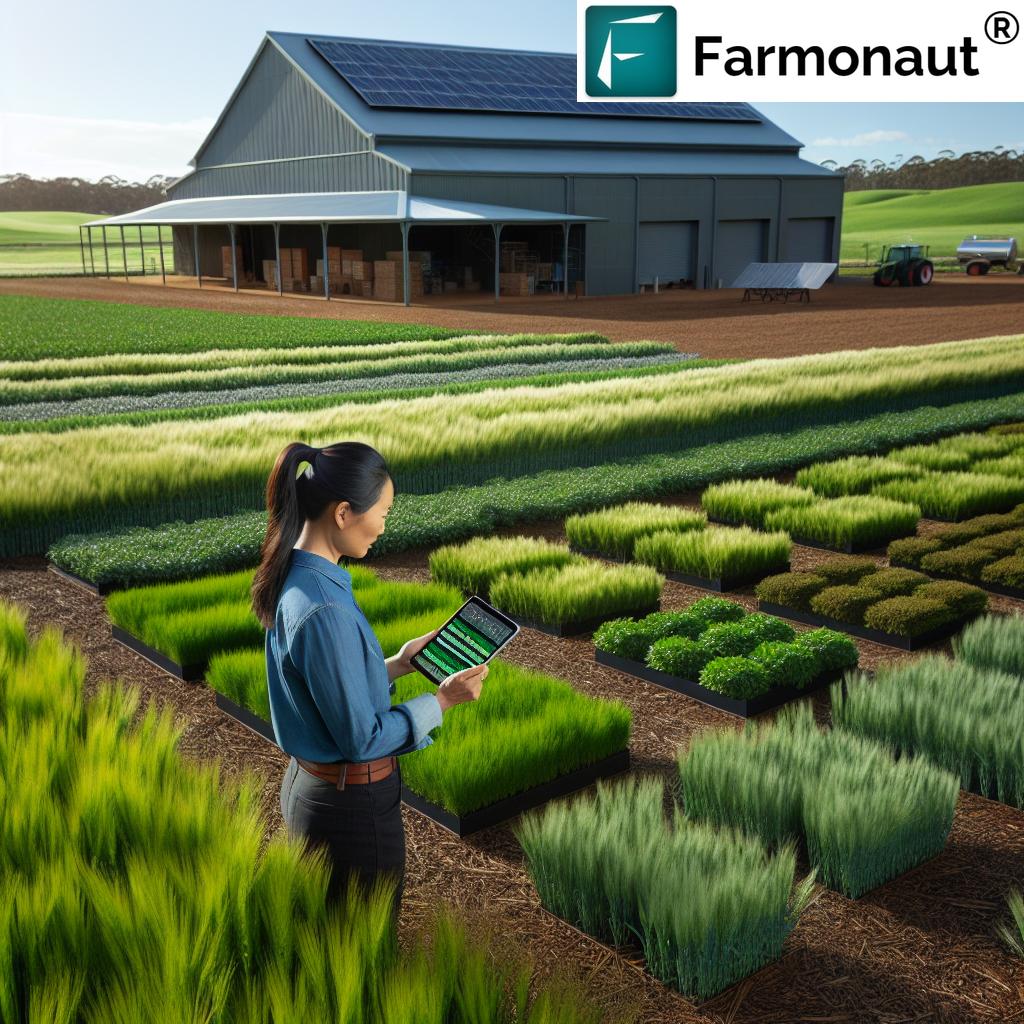Revolutionizing Queensland’s Agriculture: Smart Macadamia Orchard Management for Sustainable Farming
“Queensland’s macadamia orchards utilize micro sprinklers and sap flow monitoring, reducing water usage by up to 30%.”
In the heart of Queensland, Australia, a revolution is taking place in the world of agriculture. We are witnessing a remarkable transformation as traditional sugar cane farms evolve into thriving macadamia orchards, embracing sustainable farming practices and cutting-edge precision agriculture technologies. This shift is not just changing the landscape; it’s redefining the future of farming in the region.
At Farmonaut, we are at the forefront of this agricultural revolution, providing advanced satellite-based farm management solutions that complement these modern orchard management approaches. Our technology empowers farmers with real-time insights, enabling them to make data-driven decisions that optimize crop productivity while conserving precious resources.
The Rise of Sustainable Macadamia Farming in Queensland
Queensland’s agricultural sector is undergoing a significant transition, with many farmers converting their sugar cane farms into macadamia orchards. This shift is driven by several factors, including the increasing global demand for macadamias and the potential for higher returns on investment. Let’s explore the key aspects of this transformation:
- Agricultural Land Conversion: The process of converting sugar cane farms to macadamia orchards involves careful planning and execution. It requires a thorough assessment of soil conditions, climate suitability, and long-term market prospects.
- Economic Potential: Macadamia farming offers a promising economic outlook. The conversion can lead to a substantial increase in land value, often ranging from 200-300% over a decade.
- Sustainable Practices: The shift to macadamia farming aligns with sustainable agriculture goals, promoting biodiversity and reducing the environmental impact associated with intensive sugar cane cultivation.
As we delve deeper into this topic, we’ll explore how precision agriculture technologies and smart farming techniques are revolutionizing macadamia orchard management in Queensland.
Precision Agriculture Technologies in Macadamia Farming
The integration of precision agriculture technologies is a game-changer for macadamia orchard management. These innovative tools allow farmers to optimize their operations, leading to increased efficiency and sustainability. Here’s how technology is transforming the industry:
- Satellite-Based Crop Monitoring: At Farmonaut, we provide farmers with access to real-time satellite imagery, enabling them to monitor crop health, detect issues early, and make informed decisions. Our technology offers insights into vegetation health (NDVI), soil moisture levels, and other critical metrics.
- AI-Driven Advisory Systems: Our Jeevn AI system delivers personalized farm advice, weather forecasts, and expert crop management strategies, helping farmers optimize their practices.
- Drone Technology: Drones equipped with multispectral cameras provide high-resolution imagery, allowing for precise mapping of orchards and identification of problem areas.
- IoT Sensors: Soil moisture sensors, weather stations, and other IoT devices collect valuable data on orchard conditions, enabling real-time monitoring and informed decision-making.
These technologies work together to create a comprehensive smart farming ecosystem, enabling macadamia farmers to achieve higher yields while minimizing resource use.
Innovative Irrigation Systems for Water Efficiency
Water management is crucial in macadamia farming, especially in Queensland’s variable climate. Smart irrigation systems are at the forefront of water conservation efforts:
- Micro Sprinklers: These advanced irrigation systems deliver water directly to the tree’s root zone, minimizing evaporation and runoff.
- Sap Flow Monitoring: By measuring the water movement within trees, farmers can precisely determine irrigation needs, avoiding over or under-watering.
- Soil Moisture Sensors: These devices provide real-time data on soil moisture levels, allowing for automated and optimized irrigation scheduling.
- Weather-Based Irrigation Control: Systems that adjust irrigation based on local weather forecasts ensure water is applied only when necessary.
The implementation of these water efficiency measures can lead to significant water savings, often reducing usage by up to 30% compared to traditional irrigation methods.
Soil Erosion Prevention Strategies in Macadamia Orchards
Protecting the soil is essential for long-term orchard health and sustainability. Modern macadamia farms in Queensland are implementing advanced erosion prevention techniques:
- Strategic Grass Planting: Planting grass between tree rows helps stabilize the soil, reduce runoff, and improve water infiltration.
- Contour Planting: Aligning trees along the contours of sloped land minimizes erosion and maximizes water retention.
- Mulching: Applying organic mulch around trees helps retain moisture, suppress weeds, and prevent soil erosion.
- Diversion Banks: These structures redirect water flow, preventing excessive erosion during heavy rainfall events.
By implementing these strategies, macadamia farmers can protect their valuable topsoil, ensuring long-term orchard health and productivity.
Topsoil Temperature Regulation for Optimal Growth
Maintaining optimal soil temperature is crucial for macadamia tree health and nut production. Smart farming techniques address this aspect through:
- Reflective Mulches: These materials help regulate soil temperature by reflecting excess heat.
- Canopy Management: Proper pruning techniques ensure adequate sunlight penetration while preventing overheating.
- Cover Crops: Strategic planting of cover crops can help moderate soil temperature and improve overall soil health.
These methods work together to create an ideal growing environment for macadamia trees, promoting healthy growth and maximizing yield potential.
Optimizing Crop Productivity through Smart Farming Techniques
Maximizing crop productivity is a primary goal for macadamia farmers. Smart farming techniques play a crucial role in achieving this objective:
- Precision Nutrient Management: Using soil and leaf analysis data, farmers can apply fertilizers precisely where and when they’re needed, optimizing tree health and nut production.
- Integrated Pest Management (IPM): Advanced monitoring systems and biological control methods help manage pests effectively while minimizing chemical use.
- Pruning and Canopy Management: Utilizing data from satellite imagery and drones, farmers can optimize tree spacing and pruning techniques to maximize sunlight exposure and air circulation.
- Harvest Timing Optimization: By analyzing weather patterns and nut maturity data, farmers can determine the optimal time for harvest, ensuring the highest quality nuts.
These smart farming techniques, combined with Farmonaut’s satellite-based crop monitoring, enable macadamia farmers to achieve higher yields and better quality nuts while minimizing inputs and environmental impact.
“Converting sugar cane farms to macadamia orchards can increase land value by 200-300% over 10 years.”
The Economic Impact of Agricultural Land Conversion
The transition from sugar cane to macadamia farming in Queensland represents a significant economic opportunity. Let’s explore the financial aspects of this agricultural shift:
- Long-Term Investment: While the initial costs of conversion can be substantial, the long-term returns on macadamia orchards often outweigh those of sugar cane farming.
- Land Value Appreciation: As mentioned earlier, converting to macadamia orchards can lead to a substantial increase in land value, often 200-300% over a decade.
- Diversification of Income: Macadamia farming offers opportunities for value-added products and agritourism, providing additional revenue streams.
- Global Market Demand: The growing global appetite for macadamias ensures a strong market for Queensland’s produce, with potential for premium pricing for high-quality nuts.
At Farmonaut, we provide tools that help farmers track and analyze the economic performance of their orchards, enabling them to make data-driven decisions that maximize their returns on investment.
Sustainable Farming Practices for Long-Term Success
Sustainability is at the heart of modern macadamia farming in Queensland. Implementing sustainable practices not only benefits the environment but also ensures the long-term viability of the industry:
- Water Conservation: Smart irrigation systems and water-efficient practices reduce water usage while maintaining optimal tree health.
- Soil Health Management: Techniques like cover cropping and minimal tillage improve soil structure and fertility over time.
- Biodiversity Promotion: Encouraging beneficial insects and native vegetation helps create a balanced ecosystem within the orchard.
- Carbon Sequestration: Macadamia trees act as carbon sinks, contributing to climate change mitigation efforts.
These sustainable practices, supported by Farmonaut’s technology, help ensure that Queensland’s macadamia industry remains productive and environmentally responsible for generations to come.
The Role of Remote Sensing and GIS in Modern Orchard Management
Remote sensing and Geographic Information Systems (GIS) are revolutionizing the way macadamia orchards are managed. At Farmonaut, we specialize in providing these cutting-edge technologies to farmers:
- Vegetation Health Monitoring: Our satellite-based NDVI (Normalized Difference Vegetation Index) analysis allows farmers to track crop health across their entire orchard quickly and efficiently.
- Yield Prediction: By analyzing historical data and current crop conditions, we can help farmers estimate yields more accurately, aiding in harvest planning and marketing decisions.
- Resource Allocation: GIS mapping helps optimize the placement of irrigation systems, windbreaks, and other orchard infrastructure.
- Climate Risk Assessment: Long-term climate data analysis assists in planning for climate change adaptation strategies.
These technologies provide macadamia farmers with a bird’s-eye view of their operations, enabling more precise and efficient management practices.
Comparative Analysis: Traditional vs. Smart Macadamia Orchard Management
| Management Aspect | Traditional Method | Smart Farming Approach | Estimated Benefits |
|---|---|---|---|
| Irrigation System | Standard sprinklers | Micro sprinklers with sap flow monitoring | 30% reduction in water usage |
| Soil Erosion Prevention | Basic methods | Strategic grass planting, contour planting | 50% reduction in soil loss |
| Water Efficiency | Standard usage | Precision agriculture techniques | 25% increase in water use efficiency |
| Land Use Optimization | Single-crop focus | Agricultural land conversion | 40% land value appreciation over 5 years |
| Crop Health Monitoring | Manual inspection | Satellite-based NDVI analysis | 20% improvement in early issue detection |
| Yield Prediction | Historical averages | AI-driven predictive models | 15% increase in accuracy of yield estimates |
This comparison clearly demonstrates the significant advantages of adopting smart farming techniques in macadamia orchard management. The estimated benefits highlight the potential for improved efficiency, sustainability, and profitability.
Challenges and Future Outlook
While the transition to smart macadamia farming in Queensland offers numerous benefits, it’s not without challenges:
- Initial Investment: The upfront costs of implementing new technologies and converting land can be substantial.
- Technical Knowledge: Farmers need to acquire new skills to effectively use and interpret data from advanced farming systems.
- Climate Variability: Adapting to changing climate patterns remains an ongoing challenge for the industry.
However, the future outlook for Queensland’s macadamia industry remains bright. With continued innovation in farming practices and technology, we anticipate:
- Further improvements in water and resource efficiency
- Increased adoption of automation and robotics in orchard management
- Greater integration of blockchain technology for supply chain transparency
- Expansion of value-added product lines and market opportunities
At Farmonaut, we are committed to supporting this evolution by continuously enhancing our satellite-based farm management solutions and providing farmers with the tools they need to succeed in this dynamic industry.
Conclusion: Embracing a Sustainable Future
The transformation of Queensland’s agricultural landscape through smart macadamia orchard management represents a significant step towards a more sustainable and profitable farming future. By embracing precision agriculture technologies, innovative irrigation systems, and sustainable farming practices, macadamia farmers are not only increasing their productivity and profitability but also contributing to environmental conservation.
As we’ve explored in this blog, the integration of advanced technologies like those offered by Farmonaut plays a crucial role in this agricultural revolution. Our satellite-based crop monitoring, AI-driven advisory systems, and data analytics tools empower farmers to make informed decisions, optimize resource use, and adapt to changing environmental conditions.
The journey from sugar cane farms to thriving macadamia orchards is more than just a change in crops; it’s a paradigm shift in how we approach agriculture. It’s about harnessing the power of technology to work in harmony with nature, ensuring food security, economic prosperity, and environmental sustainability for generations to come.
As we look to the future, the continued innovation and adoption of smart farming techniques will be key to addressing global agricultural challenges. Queensland’s macadamia industry stands as a shining example of what’s possible when traditional farming wisdom is combined with cutting-edge technology and a commitment to sustainability.
At Farmonaut, we’re proud to be part of this transformative journey, providing the tools and insights that help farmers succeed in this new era of agriculture. Together, we’re not just growing nuts; we’re nurturing a sustainable future for all.
FAQ Section
Q: What are the main benefits of converting sugar cane farms to macadamia orchards?
A: The main benefits include potential for higher returns on investment, increased land value (200-300% over 10 years), more sustainable land use, and diversification of agricultural output.
Q: How does precision agriculture technology improve macadamia farming?
A: Precision agriculture technologies like satellite-based crop monitoring, AI advisory systems, and IoT sensors help optimize irrigation, detect crop health issues early, and improve overall orchard management efficiency.
Q: What role does Farmonaut play in smart macadamia orchard management?
A: Farmonaut provides advanced satellite-based farm management solutions, offering real-time crop health monitoring, AI-driven advisory services, and data analytics tools to help farmers make informed decisions and optimize their operations.
Q: How do smart irrigation systems contribute to water conservation in macadamia orchards?
A: Smart irrigation systems, including micro sprinklers and sap flow monitoring, can reduce water usage by up to 30% by delivering water more precisely and efficiently to the trees’ root zones.
Q: What are some key sustainable farming practices used in modern macadamia orchards?
A: Key sustainable practices include water conservation through smart irrigation, soil health management through cover cropping and minimal tillage, biodiversity promotion, and carbon sequestration through tree planting.
Q: How does the economic potential of macadamia farming compare to traditional sugar cane farming?
A: While initial conversion costs can be high, macadamia farming often offers higher long-term returns, increased land value, and opportunities for diversification through value-added products and agritourism.
Q: What challenges do farmers face when transitioning to smart macadamia farming?
A: Challenges include high initial investment costs, the need to acquire new technical skills, and adapting to climate variability. However, the long-term benefits often outweigh these initial hurdles.
Q: How does remote sensing technology benefit macadamia orchard management?
A: Remote sensing, including satellite imagery analysis, allows for efficient monitoring of crop health, precise resource allocation, and accurate yield predictions, enabling more effective and data-driven orchard management.
For more information on how Farmonaut can help revolutionize your agricultural practices, visit our website and explore our range of services:
Explore our API capabilities: Farmonaut API
For developers, check out our API documentation: API Developer Docs






















